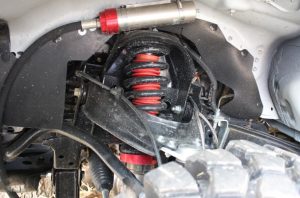Driving in winter isn’t just about swapping out your tires or topping up antifreeze. One of the most overlooked — yet essential — components affected by cold weather is your shock absorbers. These critical parts of your suspension system not only contribute to ride comfort but also to vehicle control and braking, which are especially vital in slippery, icy conditions.
This article explores how winter weather affects shock absorbers, signs they might be underperforming, how to maintain them in freezing temperatures, and what makes winter-capable shocks different.

What Do Shock Absorbers Do?
Shock absorbers, also known as dampers, are responsible for:
-
Controlling the up-and-down motion of the vehicle’s suspension
-
Keeping tires in contact with the road
-
Reducing bounce after bumps and potholes
-
Improving braking performance and steering control
In cold weather, these functions become even more important due to slippery surfaces and unpredictable road conditions.
How Cold Weather Affects Shock Absorbers
When temperatures plummet, shock absorbers face multiple challenges that reduce their effectiveness.
| Winter Effect | Impact on Shock Absorbers |
|---|---|
| Oil thickening | Reduced responsiveness; slower piston movement |
| Rubber component hardening | Bushings and seals lose flexibility, increasing wear |
| Ice and salt exposure | Corrosion risk for metal components and mounting points |
| Freezing road surfaces | Increased demands on shock absorption due to loss of traction |
| Potholes from freeze-thaw cycles | More physical stress on suspension and shocks |
Signs of Failing Shock Absorbers in Winter
Winter conditions can amplify the symptoms of worn-out or faulty shock absorbers. Watch out for these warning signs:
-
Longer braking distances
-
Uneven tire wear
-
Poor handling or swaying on icy roads
-
Knocking or clunking sounds over bumps
-
Increased bounce after going over potholes or bumps
-
ABS or traction control warnings activating more frequently
If you notice these issues, it’s time to inspect or replace your shocks.
Cold-Weather Shock Absorbers: What Makes Them Different?
Shock absorbers designed or rated for winter performance are equipped to handle the challenges of cold temperatures more effectively.
| Feature | Winter-Ready Shocks |
|---|---|
| Low-temperature hydraulic fluid | Remains viscous in sub-zero conditions |
| Durable rubber seals and bushings | Withstand hardening and cracking |
| Corrosion-resistant coatings | Protect against road salt and moisture |
| Gas-charged design | Maintains consistent damping, regardless of fluid temperature |
| Dust boots or shields | Prevent snow, ice, and grit buildup |
These features help ensure that the shocks perform optimally even in harsh climates.
Maintenance Tips for Winter Shock Absorber Performance
To ensure your shock absorbers remain effective through the winter months, follow these maintenance and inspection tips:
Inspect for Leaks and Damage
Cold weather can make seals brittle. Regularly check for hydraulic fluid leaks or physical damage to the shock body.
Clean Off Salt and Ice
Rinse off salt and grime after snowstorms to prevent rust and corrosion on the shock casing and mounting points.
Monitor Handling and Ride Quality
If your vehicle feels unusually bouncy or difficult to steer, it may be time for a shock absorber replacement.
Schedule Pre-Winter Suspension Checks
Have a mechanic inspect your shocks, struts, and suspension bushings before winter arrives.
When to Replace Your Shock Absorbers

In general, shock absorbers should be replaced every 80,000 to 100,000 km, but winter conditions can accelerate wear. Replace them sooner if:
-
Your shocks are leaking
-
Your car nose-dives when braking
-
Your tires show signs of cupping or uneven wear
-
You experience poor traction on slippery roads
A timely replacement ensures better safety and vehicle control throughout the season.
Top Tips for Safer Winter Driving with Good Shocks
| Driving Tip | Why It Matters |
|---|---|
| Slow down on snow and ice | Reduces load on shocks, improves grip |
| Avoid sudden turns or stops | Prevents suspension stress and loss of control |
| Steer smoothly over bumps and ruts | Prevents bottoming out and extends shock life |
| Reduce load in vehicle when possible | Less weight = less stress on shocks and suspension |
Where to Buy Winter-Ready Shock Absorbers
If your current shocks are worn out or not suitable for cold weather driving, it’s important to choose replacements that offer superior performance and durability.
This store offers a wide selection of shock absorbers suitable for all seasons, including winter-optimized models. Use their compatibility tools to match your vehicle exactly and enjoy fast delivery across Europe. Whether you’re preparing for winter commutes or snowy weekend getaways, they have the right suspension solutions.
Final Thoughts
Your shock absorbers play a crucial role in winter driving safety — and neglecting them can lead to serious consequences. Cold weather affects everything from the viscosity of shock oil to the flexibility of rubber components, reducing both comfort and control.
Don’t wait until you’re skidding on ice to realize your suspension is underperforming. Inspect, maintain, and upgrade your shock absorbers before the snow hits, and enjoy peace of mind knowing your vehicle can handle whatever winter throws at it.
Stay safe. Stay prepared. And keep your wheels grounded this winter.